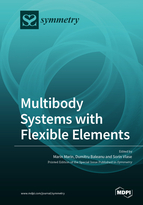Multibody Systems with Flexible Elements
A special issue of Symmetry (ISSN 2073-8994). This special issue belongs to the section "Computer".
Deadline for manuscript submissions: closed (30 April 2021) | Viewed by 39493
Special Issue Editors
Interests: differential equations; partial differential equations; equations of evolution; integral equations; mixed initial-boundary value problems for PDE; termoelasticity; media with microstretch; environments goals; nonlinear problems
Special Issues, Collections and Topics in MDPI journals
Special Issues, Collections and Topics in MDPI journals
Interests: mechanics; vibrations; elasticity; composite materials; analytical mechanics
Special Issues, Collections and Topics in MDPI journals
Special Issue Information
Dear Colleagues,
Multibody systems with flexible elements represent mechanical systems made by many elastic (and rigid) bodies interconnected meeting a functional, technical or biological assembly. The displacements of each or some of the elements of the system are generally large and cannot be neglected in mechanical modeling. The study of these multibody systems covers many industrial fields but also has applications in medicine, sports, and art. The systematic treatment of the dynamic behavior of interconnected bodies has led to an important number of formalisms for multibody systems within mechanics. At present, this formalism is used in large engineering fields, especially in robotics and vehicle dynamics. The formalism of multicorp systems offers a means of algorithmic analysis, assisted by the computer, and a means of simulating and optimizing an arbitrary movement of a possible high number of elastic bodies in the connection. The domain where researchers apply these methods are robotics, simulation in the dynamics of vehicles, biomechanics, aerospace engineering (helicopters, the behavior of cars in the gravitational field), engines with internal combustion, gearboxes, transmissions, mechanisms, the cellulose industry, simulation of particle behavior (granulated particles and molecules), dynamic simulation, military applications, computer games, medicine, and rehabilitation.
Isotropy and homogeneity of the Euclidian space and the homogeneity of the time leads to conservation laws and symmetry of differential evolution equations that describe the behavior of such mechanical systems.
Prof. Dr. Marin Marin
Prof. Dr. Dumitru Baleanu
Prof. Dr. Sorin Vlase
Guest Editors
Manuscript Submission Information
Manuscripts should be submitted online at www.mdpi.com by registering and logging in to this website. Once you are registered, click here to go to the submission form. Manuscripts can be submitted until the deadline. All submissions that pass pre-check are peer-reviewed. Accepted papers will be published continuously in the journal (as soon as accepted) and will be listed together on the special issue website. Research articles, review articles as well as short communications are invited. For planned papers, a title and short abstract (about 100 words) can be sent to the Editorial Office for announcement on this website.
Submitted manuscripts should not have been published previously, nor be under consideration for publication elsewhere (except conference proceedings papers). All manuscripts are thoroughly refereed through a single-blind peer-review process. A guide for authors and other relevant information for submission of manuscripts is available on the Instructions for Authors page. Symmetry is an international peer-reviewed open access monthly journal published by MDPI.
Please visit the Instructions for Authors page before submitting a manuscript. The Article Processing Charge (APC) for publication in this open access journal is 2400 CHF (Swiss Francs). Submitted papers should be well formatted and use good English. Authors may use MDPI's English editing service prior to publication or during author revisions.
Keywords
- multibody systems
- flexible elements
- robotics
- vehicle dynamics
- dynamic simulation
- military applications
- aerospatial engineering








